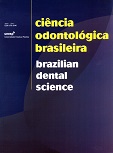Estudo comparativo do tamanho dos incisivos centrais superiores e da distância entre caninos de duas marcas comerciais de dentes artificiais
DOI:
https://doi.org/10.14295/bds.2005.v8i3.434Abstract
As tabelas de modelos de dentes artificiais das marcas Trubyte Biotone (TB) e Vipi Dent (VD) possuem quatorze mod-elos similares de dentes anteriores superiores. Os objetivos desse estudo foram: 1) – comparar o tamanho dos incisivos centrais (ICs) produzidos com o tamanho informado pelos fabricantes e 2) – comparar a largura dos seis dentes anteri-ores superiores em linha reta (LDAS) entre os modelos similares dos fabricantes. Os dentes foram obtidos no mercado e um paquímetro digital foi usado para as mensurações (em mm). No experimento 1, para cada marca, altura e largura dos ICs foram mensuradas e os dados de cada dimensão comparados pelo teste t com os valores informados na tabela de modelos. Para TB (n=19), as larguras médias mensuradas e informadas pelo fabricante foram, respectivamente, 8,04±0,72 e 8,00±0,66 e as alturas médias 9,63±1,00 e 9,76±1,01. Para VD (n=16), as larguras médias mensuradas e informadas foram, respectivamente, 7,83±0,75 e 8,01±0,71 e as alturas médias 9,85±1,06 e 9,97±1,13. Não existiu diferença estatística para as dimensões estudadas de ambas as marcas. No experimento 2, para ambas as marcas, as LDAS dos modelos similares (n=14) foram mensuradas e os dados comparados entre as marcas pelo teste t. As LDAS médias obtidas para TB e VD foram, respectivamente, 44,68±3,19 e 42,02±3,12, sendo estatisticamente diferentes. Conclusão: apesar das tabelas de modelos das marcas comerciais estudadas indicarem o mesmo tamanho para modelos com denominação igual, os da VD são menores que os da TB.Downloads
Downloads
Published
How to Cite
Issue
Section
License
Brazilian Dental Science uses the Creative Commons (CC-BY 4.0) license, thus preserving the integrity of articles in an open access environment. The journal allows the author to retain publishing rights without restrictions.
=================




























